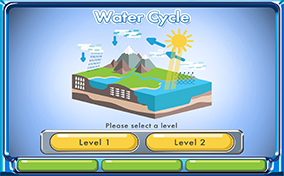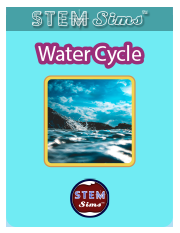Here are some definitions to help you in your investigation.
Altitude - the distance above sea level
Change of Phase - a process in which one phase of matter changes into a different phase of matter
Clay - the smallest mineral particle in a typical soil sample
Convection - the motion in a fluid that causes warmer parts of the fluid to rise and cooler parts of the fluid to sink
Data - measurement information
Density - the mass of a substance in a given volume
Distribution - how much of something and where it’s located
Fluid - a liquid or a gas
Fresh Water - liquid or solid water with little salt or other materials
Gas - a phase of matter with particles that are very far apart and move very quickly in all directions
Gravity - the force that pulls objects downward towards Earth
Ground Cover - any plant that grows over an area of the ground
Groundwater - water stored in underground areas, such as crevices in rocks and between sediments
Humidity - the amount of water vapor in the atmosphere
Infiltration - precipitation that moves underground
Kinetic Energy - energy due to the motion of something
Liquid - a phase of matter with particles that are very close together and can move slowly to change their positions
Percentage - the part of a whole
Permeable - allows fluids to pass through the substance
Pie Chart - a circle graph that divides things into slices based on percentages
Porosity - the ratio of the pores in a substance compared to the total volume of the substance
Recharging - the process in which water is added to groundwater reservoirs
Reservoir - a place where water is stored
Salt Water - liquid water with a high salt concentration
Sand - the largest mineral particle in a typical soil sample
Silt - the medium-sized mineral particle in a typical soil sample
Soil - minerals, water, air, and organic matter and animals that support growth
Surface Area - a total measure of the area on the surface of something
Surface Water - any body of water found on Earth’s surface
Temperature - the average kinetic energy of the particles in a substance
Unbalanced Forces - when one force on an object is greater than another force on the same object. This causes the motion of the object to change.
Updraft Force - the force due to convection that pushes objects upward
Vapor - a substance that normally is a liquid or solid that is in the gas phase
Wind Speed - how fast the wind is blowing
What is the Water Cycle?
The water cycle is a process that shows how water circulates through the atmosphere, hydrosphere, and lithosphere in a continuous process. The water cycle is like a big, exciting journey that water takes! It's a continuous adventure where water moves between the Earth and the sky. The sun's heat causes water to evaporate from oceans, lakes, and rivers, turning it into vapor. This vapor rises, cools, and forms clouds. When the clouds get full, water falls back to Earth as rain, snow, or hail. This water then flows into rivers, lakes, and oceans, or soaks into the ground, and the cycle begins all over again!
What is evaporation?
The process in which liquids move into the gas phase below the temperature at which the liquid normally boils. Imagine a puddle on a sunny day. Slowly, it disappears! Where does it go? It turns into an invisible gas called water vapor and floats up into the air. This is called evaporation. The sun's heat gives the water enough energy to change from a liquid to a gas. Evaporation is how water from lakes, rivers, and even the wet clothes you hang outside dry and become part of the air.
What is vapor pressure?
Imagine a closed jar with some water at the bottom. Some of the water evaporates into water vapor, filling the space above the water. These water vapor molecules bounce around and push against the walls of the jar. This "push" is called vapor pressure. The warmer the water, the more water evaporates and the higher the vapor pressure. It's like the water vapor is getting more energetic and pushing harder! Vapor pressure is an important part of understanding how weather works.
What is transpiration?
The process in which liquid water is released through pores in leaves and moves into the gas phase. Imagine a tree drinking water from the ground with its roots. The water travels up the tree's trunk and reaches the leaves. But what happens then? Tiny holes on the leaves, called stomata, release the water as an invisible gas called water vapor. This process is called transpiration. It's like the tree is sweating! Transpiration helps plants stay cool and moves water up from the roots to the leaves.
What is sublimation?
The process in which solids move directly into the gas phase without first moving through the liquid phase. Have you ever seen dry ice? It's so cold it looks like it's smoking! Dry ice is frozen carbon dioxide, and it does something really cool called sublimation. Instead of melting into a liquid, it changes directly from a solid into a gas! This is sublimation. Another example is when snow disappears on a cold, sunny day, even if the temperature stays below freezing. The snow turns directly into water vapor in the air.
What is condensation?
The process in which a gas moves into the liquid phase. Imagine a cold glass of lemonade on a hot day. Do you see those water drops forming on the outside of the glass? That's condensation! The water vapor in the air cools down when it touches the cold glass. It loses energy and changes from a gas back into tiny liquid water droplets. Condensation is also how clouds form. Water vapor in the air rises, cools, and turns back into tiny water droplets or ice crystals that clump together to make a cloud.
What is precipitation?
Precipitation is water in the atmosphere in the solid or liquid phase that falls from clouds to the ground. Think of all the ways water falls from the sky! Rain, snow, sleet, and hail are all types of precipitation. Precipitation happens when water droplets or ice crystals in clouds grow too heavy. They get so big and heavy that the air can't hold them up anymore, and they fall to the ground. Rain is liquid water, snow is fluffy ice crystals, sleet is tiny ice pellets, and hail is like big chunks of ice! Precipitation is how water in the air returns to the Earth.
What is melting?
Melting is the process in which solids move into the liquid phase. Have you ever held an ice cube in your hand? What happens? It starts to melt! Melting is when a solid, like ice, changes into a liquid, like water. This happens because the ice absorbs heat energy from your hand and the surrounding air. The heat makes the tiny particles in the ice move faster and farther apart, turning the solid ice into liquid water. Melting is why ice cream drips on a hot day and snowmen shrink in the sunshine.
What is infiltration?
infiltration is the process when precipitation that falls on the ground moves through the solid Earth and down into underground reservoirs. Imagine pouring a glass of water onto the soil in your garden. Where does the water go? It soaks into the ground! This is called infiltration. The water seeps through the tiny spaces between the soil particles and rocks. Infiltration is how rainwater replenishes the groundwater that we drink and that plants use to grow. Some soils are like sponges and allow lots of water to infiltrate, while others are more like a hard surface and allow less water to soak in.
Imagine pouring water on a pile of rocks and then on a pile of sand. Which one soaks up more water? The sand! That's because sand has more tiny spaces between its particles. This is called porosity. Ground cover, like plants and leaves, also affects infiltration. They slow down the water and give it more time to soak into the ground.
Without plants, the water might rush over the soil and cause erosion instead of infiltrating.
What is runoff?
Runoff is the process when precipitation that falls on the ground moves along the surface of the ground or from below the surface into surface waters. When rain falls on the ground, it doesn't all soak in. Some of it flows over the surface. This is called runoff. Imagine a river forming in your driveway during a storm! The amount of runoff depends on things like how steep the ground is, the type of soil, and if there are plants. Steeper hills have more runoff. Soil with lots of spaces soaks up more water, so there's less runoff. Plants help slow down the water and reduce runoff too.
What makes up soil?
Soil is like a cake made with different ingredients! The smallest particles are clay, so tiny you can't see them. Clay holds water well, making soil sticky. Next comes silt, which is bigger than clay but still feels smooth. The largest particles are sand, which you can see and feel easily. Sand helps water drain quickly. Soil also has organic matter like dead leaves and bugs, which gives plants food. The mix of these particles makes different types of soil!
 The water cycle, also called the hydrological cycle, shows how water moves through the environment on Earth. Evaporation, condensation, precipitation, and recharging are all parts of the cycle. Can you fine tune each of these cycle elements to create the most efficient water cycle possible? Get ready to pour yourself into this investigation of the water cycle.
The water cycle, also called the hydrological cycle, shows how water moves through the environment on Earth. Evaporation, condensation, precipitation, and recharging are all parts of the cycle. Can you fine tune each of these cycle elements to create the most efficient water cycle possible? Get ready to pour yourself into this investigation of the water cycle.

